Shorter DOJ: We Made Shit Up … Please Free Mike Flynn
Congratulations to the lawyers who worked all weekend to meet Judge Emmet Sullivan’s deadline to certify all the documents (with just eight explicit caveats and then another slew built in) submitted in the Mike Flynn motion to dismiss proceeding. I doubted you could pull it off time-wise.
In your rush you seem to have provided Judge Sullivan even more evidence that nothing about this proceeding is normal. Indeed, some of this submission almost makes Sidney Powell’s submissions look tidy by comparison.
The slew of caveats
Effectively, the certification (signed by Jocelyn Ballantine, with individual declarations signed by three others, in part because there are things that Ballantine almost certainly knows are inaccurate or include material omissions), says there have been no material alterations to the documents submitted in the proceeding except for:
- Redactions done in the name of classification, law enforcement sensitive, or privacy that serve to hide material information pertaining to Brandon Van Grack, Bill Barnett, and the reason a third document was altered by adding a date (at a minimum)
- A set of texts where “irrelevant information and excess metadata” was excluded and an error introduced in the process of creating a table showing “corrected date, corrected time,” which raises far more questions about the provenance of the document
- The Bill Barnett interview report that DOJ had submitted to Sullivan as “a 302” is instead a “report” that is not being certified in normal fashion, in part, because DOJ is hiding redactions that withhold material information about Brandon Van Grack
- An NSL declaration done by Jocelyn Ballantine that may hide the existence of at least one earlier financial NSL served on Mike Flynn that WDMO didn’t ask her to summarize
- A new set of text messages between Peter Strzok and Lisa Page that DOJ admits they’re not relying on (but nevertheless committed an additional Privacy Act violation in releasing), which was not redacted to hide personal information
- Three documents submitted by Sidney Powell that DOJ won’t certify (two of which, however, are probably more accurate than what DOJ has submitted)
- “Unintelligible” markings in transcripts of notes where DOJ was unsuccessful at getting the author or their lawyer to conduct a last minute review over a matter of hours on a Sunday (DOJ does not specify how many of their transcripts this includes); some of these appear significant
- Inconsistencies on how redactions and unintelligible text were marked in transcriptions which, in some cases, is affirmatively misleading
- Lots of documents where the certification doesn’t list the Bates numbers, with some hilarious results
- Inconsistencies on whether DOJ certifies all copies of a particular document that got submitted multiple times, which in one case would raise questions about the production of these documents
- An admission that, for some reason, the motion to dismiss didn’t rely on the final 302 of Flynn’s January 24, 2017 interview
- A new inaccurate date, ironically describing a Kevin Clinesmith email
- A claim that both Strzok and McCabe’s lawyers have confirmed their clients’ notes were not altered, but only Strzok’s lawyer is quoted
For all of the exhibits that accompanied the motion to dismiss, DOJ uses the docket number, not the exhibit number, even though Sullivan is supposed to be ruling on that MTD that uses exhibit numbers. That’ll make it a lot harder for him to use the transcriptions, which otherwise would make it more obvious that DOJ misrepresented what some of these documents say, including their “smoking gun,” the Bill Priestap notes.
In addition, in a lot of the documents with problems (including all undated notes to which dates were added), DOJ doesn’t include Bates numbers in its certification, even though it does elsewhere. There’s good reason for this. In the case of the re-altered altered documents, those new exhibits should have new Bates stamps, but don’t. In other cases, DOJ submitted multiple versions of the same document with different Bates stamps, in others, when they resubmitted exhibits they retained the Bates stamp. That’s … not a legal process reflecting any regularity.
DOJ still pretends to have no fucking clue about documents they relied on in the motion to dismiss
Perhaps the most pathetic (and by that I mean, I would hate to be the lawyer banking my bar membership on this ploy) detail in this package is the way they try to deal with the fact they’ve made false misrepresentations about Strzok’s January 5, 2017 notes. In one place in the table of documents, they describe the date of the notes this way:
In another, they describe it — the very same notes, just repackaged so they could submit them with the wrong date — this way:
Above both transcriptions, DOJ includes the following note.
I understand why DOJ is still claiming to be unsure about the date. It’s an attempt to minimize the damage from previously providing false dates so as to avoid being punished for knowing misrepresentations in their alterations (they’re still at risk though, because they’re incorrect dates kept changing). But this will just make it very easy for Sullivan to point out that the people making this representation are therefore confessing to being completely unfamiliar with documents on which the MTD heavily relies, which means he shouldn’t take the MTD all that seriously.
The shell game behind the actual declarations
As noted, this declaration is a filing signed by Jocelyn Ballantine, submitting declarations from three other people:
- Executive Assistant Director John Brown, whose job it is to submit declarations like this
- EDMO AUSA Sayler Fleming, one of the AUSAs conducting this irregular investigation
- Keith Kohne, one of the FBI Agents conducting the investigation
Brown starts by excluding three documents from his general certification (these are the ones that Fleming and Kohne will be on the hook for):
5. To the best of my knowledge, and based on the information provided to me, the Government Exhibits described in Exhibit A, 9 with the exception of ECF Nos. 198-8 and 249-1, are true and correct copies of documents and records, including copies of select pages of a larger record, maintained by the FBI pursuant to the applicable records retention policy. See ECF Nos. 198-2, 198-3, 198-4, 198-5, 198-6, 198-7, 198-9, 198-10, 198-11, 198-12, 198-13, and 198-14 9 9
6 To the best of my knowledge, and based on the information provided to me, the Discovery Documents described in Exhibit B, with the exception of ECF Nos. 228-3, are true and correct copies of documents and records maintained by the FBI pursuant to the applicable records retention policy. See ECF Nos. 231-1, 237-1. 251-1, 9 257-1. 259-1, 9 259-2, 259-3, and 264-1
Effectively, he is saying these documents are real and that Ballantine’s claims about the reasons for classification are valid.
He then says this about Ballantine’s own summary, which purports to be a summary of all the NSLs used against Mike Flynn, but which may not include one or more financial NSLs obtained in 2016.
One of the Discovery Documents is a summary substitution of classified materials that were provided to DC-USAO by the FBI. See ECF 257-2. This summary substitution was prepared by AUSA Jocelyn Ballantine, and was reviewed, approved, and declassified by the FBI To the best of my knowledge, and based on the information provided to me, the information contained therein truly and correctly summarizes the underlying classified information provided by the FBI and maintained by the FBI pursuant to the applicable records retention policy.
He’s saying that her summary accurately summarizes what she says it does, but he’s not saying that her description of it is accurate (which it wouldn’t be if EDMO told her to leave out 2016 NSLs).
Then it’s Fleming’s turn. After reviewing her role in this shoddy review and asserting that she has no reason to believe that the documents she got from FBI were irregular, she then explains why she did a summary of the texts that Strzok and a bunch of other people sent in early 2017: Just to get rid of unnecessary metadata, she says.
3. Among the documents and records that I reviewed were spreadsheets of electronic messages exchanged between FBI personnel involved in the Michael T. Flynn investigation and prosecution. The spreadsheets produced to EDMO contained messages and metadata that were not relevant to my review.
4. I created Government Exhibit ECF 198-8 and Discovery Document ECF 228-3. These exhibits truly and correctly reflect excerpts from documents and record maintained by the FBI pursuant to the applicable records retention policy that were provided to EDMO/DC-USAO for review.1
Then she admits someone — she doesn’t say who — made an error.
1 There is a single typographical error in these exhibits. A single message (“Will do.”) from DAD Peter Strzok, sent on 4-Jan-17, is incorrectly identified as having been sent at 2:17PM; the message was actually sent at 2:18PM.
What she doesn’t explain, though, is why her table has two headings that show she or someone else had to “correct” the dates and times in the spreadsheet (which may be where the typo got introduced, or retained).
Given that heading, she has no business treating the data she got as reliable, because either she or someone upstream from her had to fix it.
Then Keith Kohne steps in, the guy who conducted an incompetent interview (and possibly one of the guys who altered dates on government exhibits). He doesn’t provide any explanation of why he’s making the declaration — not even the standard boilerplate you’d find in an affidavit. He says only,
I, Keith Kohne, hereby declare, pursuant to 28 U.S.C. § 1746, that the document attached as Exhibit 1 to the Government’s Supplemental Filing in Support of Motion to Dismiss … is a true and correct copy of the report of the interview of William J. Barnett conducted on September 17, 2020.
Understand that this declaration lacks the certification afforded by the rules of FBI record-keeping. It lacks Brown’s certification that the data in was redacted properly (this was not). And it doesn’t explain why it wasn’t finalized as a 302 and submitted into FBI record-keeping systems.
Collectively, then, these declarations stop well short of certifying those texts, Ballantine’s summary, or the Barnett’s interview.
We already know that the Barnett interview is withholding material information. I guess we should assume there are problems with the other two documents as well.
Documents and comments
Here are the documents:
Draft closing communication (198-2) [Docket 2, Exhibit 1]
In the certification but not the exhibit referenced, DOJ redacts Bill Barnett’s name, who wrote the document, as well as that of Joe Pientka, who approved it. That serves to make it harder to figure out that the closing EC materially conflicts with unredacted claims Barnett made in his interview, particularly with regards to Barnett’s awareness that the investigation was a counterintelligence investigation considering 18 USC 951 charges.
It’s all the more problematic given that DOJ has submitted two versions of this document with the same Bates numbers; the earlier one does have the names redacted.
Opening Electronic Communication (198-3) [Docket 3, Exhibit 2]
This doesn’t include Bates numbers.
Mary McCord 302 (198-4) [Docket 4, Exhibit 3]
As with other documents, this one was specially declassified for this release. Another copy has been released under BuzzFeed’s FOIA.
Sally Yates 302 (198-5) [Docket 5, Exhibit 4]
Flynn got a summary of this before he allocuted his guilty plea before Sullivan.
170302 Jim Comey Transcript (198-6) [Docket 6, Exhibit 5]
As DOJ notes, HPSCI used a court reporter on this, so they didn’t have to certify it.
170214 Draft Flynn 302 (198-7) [Docket 7, Exhibit 6]
For some reason (I’ll return to this), DOJ submitted a draft version of the 302, rather than the final one (both have previously been submitted in this docket, and a less-redacted version of the 302 was released prior to this in BuzzFeed’s FOIA). Nowhere in the motion to dismiss does Timothy Shea acknowledge that he wasn’t relying on the final 302.
Text massages and electronic messages (198-8) [Docket 8, Exhibit 7]
The certification doesn’t include Bates stamps.
This is the document that has an admittedly minor error in one of the time stamps, saying that Strzok texted “Will do” at 2:18 instead of 2:17. But the error is interesting given that the table’s headings read, “Corrected Date, Corrected Time,” meaning these aren’t just copied, the times (and dates) were “corrected” (which is presumably where the error was introduced), raising questions about what they were corrected from. [My annotation.]
This is one of the documents that FBI EAD John Brown did not certify, which ought to raise questions about how these dates and times got “corrected.” Instead, the authentication reads:
Truly and correctly reflects information contained in documents and records maintained by the FBI, pursuant to the applicable records retention policy that were provided to EDMO.
Without an explanation of how why this data needed to be corrected, I think there are real questions whether this fulfills the requirement here.
Emails about the Logan Act (198-9) [Docket 9, Exhibit 8]
The certification doesn’t include Bates numbers.
170121-22 Emails about providing briefings (198-10) [Docket 10, Exhibit 9]
This certification doesn’t include Bates numbers.
170124 Emails of questions Flynn might ask (198-10) [Docket 10, Exhibit 9]
This certification doesn’t include Bates numbers. This matters both because they’re mixing docket number and exhibit number, but also because there are two copies of the identical document with a different Bates number in the docket.
Emails about 1001 warnings (198-10) [Docket 10, Exhibit 9]
This certification doesn’t include Bates numbers. This matters both because they’re mixing docket number and exhibit number, but also because there are two copies of the identical document with a different Bates number in the docket.
170124 Bill Priestap Notes (198-11) [Docket 11, Exhibit 10]
This certification doesn’t include Bates numbers. This matters both because they’re mixing docket number and exhibit number, but also because there are two copies of the same document with a different Bates number in the docket, yet both have the blue sticky that is hidden in later documents (raising questions about why there are two separate direct scans).
170124 Andrew McCabe write-up (198-12) [Docket 12, Exhibit 11]
This document doesn’t have a Bates stamp on it at all, which is especially problematic given that another less redacted version of the document is in this docket, with a Bates stamp of the same series as other documents submitted with the motion to dismiss.
The May version, with the Bates stamp, makes it clear that McCabe agreed with Flynn that leaks were a problem. [My annotations.]
The motion to dismiss version redacts that.
McCabe’s comment about leaks in no way qualifies under any claimed basis for redaction stated in certification.
It also appears to redact the prior declassification stamp.
One thing DOJ did by submitting this without a Bates stamp is avoided admitting that the document is not at all new, as the Motion to Dismiss suggested.
170124 Strzok and Pientka Notes of Flynn interview (198-13) [Docket 13, Exhibit 12]
These were released as the same exhibit, which given that they don’t use Bates numbers to identify which is which, effectively means they haven’t told Judge Sullivan which Agent’s notes are which, something that Sidney Powell wailed mightily about the last time it happened. They do, however, get it right in the transcript.
In the Pientka notes, however, there are numerous examples of things that are clear, at least from the context, that don’t get transcribed properly.
170822 Strzok 302 (198-14) [Docket 14, Exhibit 13]
This had already been produced in this docket.
200917 “Report” of Bill Barnett’s interview (249-1)
In the Government Supplemental Filing accompanying this interview, they claim that this is, “The FBI 302” of the Barnett interview. Here, they’re correctly noting that it’s not actually a 302, which makes it even more problematic than it already was.
The certification makes it clear that this “report” is maintained differently than normal 302s. Rather than certifying it as,
True and correct copy of a document or record maintained by the FBI pursuant to the applicable records retention policy.
It is instead certified as,
True and correct copy of the report of that interview.
I’m not sure Sullivan is going to be that thrilled that FBI itself is not treating this interview with the regularity of other investigative documents.
This “report” is probably one of the reasons why DOJ included this language in the filing.
There have been no material alterations made to any of the 14 Government Exhibits filed in support of the motion to dismiss and the supplement to the motion to dismiss. Several of the documents contain routine redactions made by the FBI to protect classified information, and/or law enforcement sensitive information, and/or made to comply with the Local Rule to remove Privacy Act information.
As I have laid out, DOJ withheld material information — most notably, all the nice things Barnett said about Brandon Van Grack — by redacting information that would otherwise be unsealed.
This is one of the documents that EAD John Brown did not certify; instead, one of the agents who did the interview did, which suggests it could not be certified properly. It also suggests that Ballantine, who knows it is withholding material information, doesn’t want to be in a position where she can see it (even though she sent an unredacted copy to Flynn).
The certification notes these are identical to the 198-8 text messages, with the error under heading, “corrected time.” It’s unclear why, in this one case, DOJ admitted to the same exhibit being filed multiple times, since in other cases they don’t note it.
The transcription of these notes don’t note the redactions. That’s significant because the only difference between this set of notes and the later, altered ones, is that they declassified a bit more information in the latter case.
170125 Gauhar Notes (237-1)
The transcription is inconsistent about whether it treats cross-outs as unintelligible or not, in one place treating a heading “Intro” as intelligible, but not references to “Thanksgiving” and “He said.”
170125 Strzok Notes (237-1)
By labeling these notes as Strzok’s, DOJ makes it more clear that they redacted information that must match other sets of notes from the same meeting.
170130 [Draft] Executive Summary of Flynn investigation (237-1)
The certification doesn’t reveal that this is a draft document, not a finalized one.
170330 Dana Boente Notes (237-1)
Undated McCabe Notes (248-2/259-1)
The transcription doesn’t note that McCabe crossed off his notes on Flynn. Nor does it admit that it redacted what appears to be a continuation of the discussion of Flynn.
The authentication notes that it is,
True and correct copy of a document or record maintained by the FBI pursuant to the applicable records retention policy (ECF 259-1)
That means they’re only certifying that this is something in FBI records (which it shouldn’t be, since it’s a re-altered altered document).
They also leave out Bates numbers, which is problematic because the re-altered document is technically a new document, but it retains the same Bates stamp.
170105 Strzok Notes (248-3/259-2)
The transcription reveals that two of the three new things revealed in the new copy were unintelligible to DOJ, which raises real questions about why they left it unredacted.
The authentication notes that it is,
True and correct copy of a document or record maintained by the FBI pursuant to the applicable records retention policy (ECF 259-2)
That means they’re only certifying that this is something in FBI records (which it shouldn’t be, since it’s a re-altered altered document).
They also leave out Bates numbers, which is problematic because the re-altered document is technically a new document, but it retains the same Bates stamp.
Undated Strzok Notes (248-4/259-3)
As with some others, the transcription doesn’t note all the redactions, which in this case raises questions about why they included notes from the day before.
In addition, they leave out a scribble in front of the word “willfullness” meaning Strzok switched what they were measuring with regards to whether Flynn’s lies about Turkey were deliberate.
The authentication notes that it is,
True and correct copy of a document or record maintained by the FBI pursuant to the applicable records retention policy (ECF 259-3)
That means they’re only certifying that this is something in FBI records (which it shouldn’t be, since it’s a re-altered altered document).
They also leave out Bates numbers, which is problematic because the re-altered document is technically a new document, but it retains the same Bates stamp.
170306 Jim Crowell Notes (251-1)
As expected, DOJ was thoroughly dishonest with this document. They don’t reveal that they’ve redacted something — either a date, or names — where they indicate that they’ve added a date. One way or another, this transcription is false.
Plus, if they’ve redacted the names of non-senior people in the meeting (which is the non-suspect excuse for the redaction), then they need to note that in the transcription. The alternative, of course, is worse, that they knowingly altered the date.
This is one instance where not revealing whether DOJ consulted with the author is especially problematic. But since Crowell is now a DC judge just next door to Sullivan’s courthouse, maybe he can just go ask.
161226 Clinesmith NSL Email (257-1)
The certification provides the wrong date for this email, labeling it 12/26/16. [My annotations.]
it was 12/23/16.
Unlike some of the other things here, I think this is just a sloppy error, not an affirmative misrepresentation. But it is ironic that they made the error with Clinesmith.
200924 Ballantine Summary Substitution of NSLs issued in Crossfire Razor (257-2)
In her notice of discovery correspondence accompanying this, Ballantine doesn’t note that she wrote this summary for EDMO to review for them to, in turn, give back to her to give to Flynn. That’s important, because it’s unclear whether the summary shows all NSLs, or only NSLs for the period in question. Both Barnett’s testimony and the Kevin Clinesmith email included suggest the latter.
This doesn’t include Bates numbers, which is interesting because an older 2019 Bates stamp not seen elsewhere is included (possibly indicating that this was previously shared with DOJ IG).

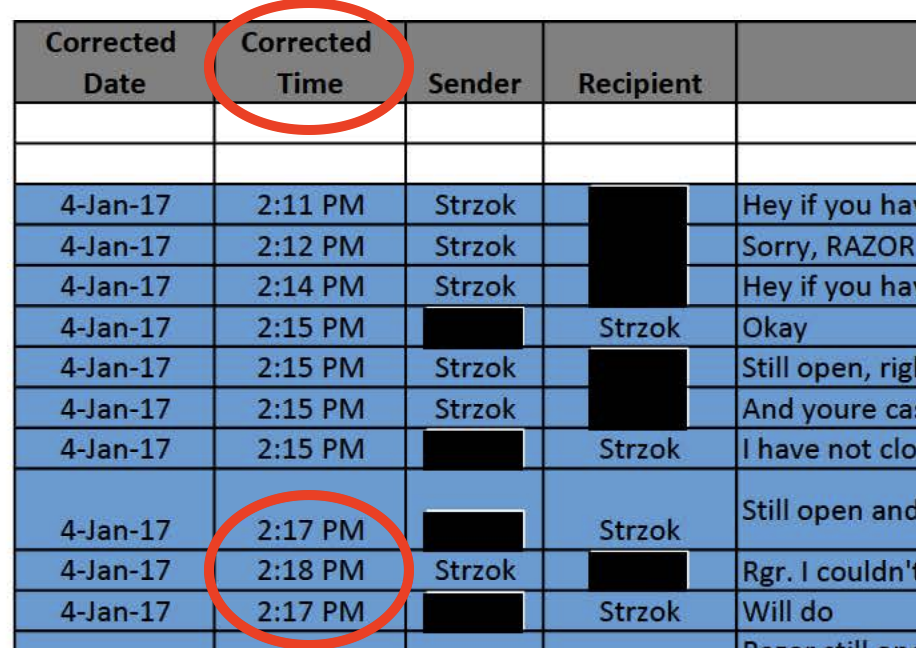
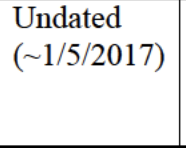
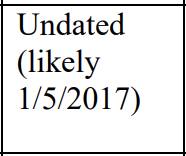

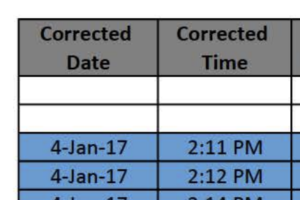



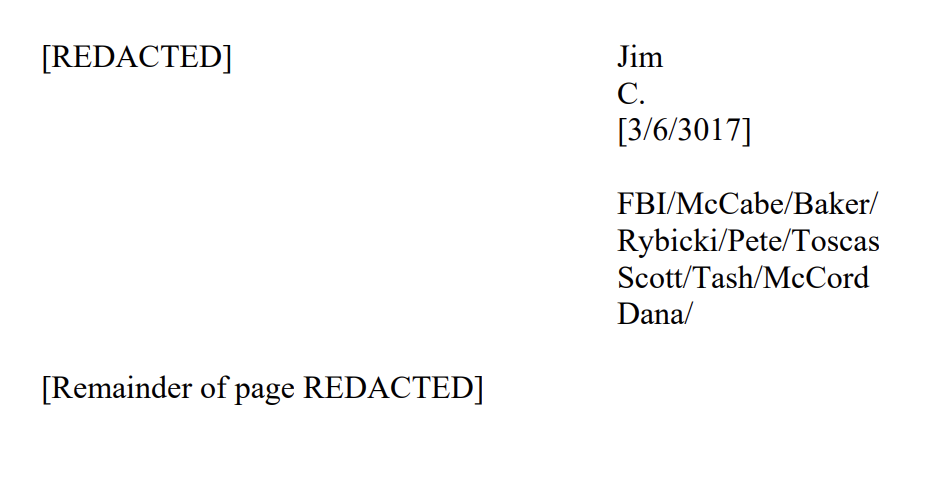





Case 1:17-cr-00232-EGS Document 306-1 Filed 10/26/20 Page 1 of 3
has date as “2014” for
“Draft closing communication (198-2) [Docket 2, Exhibit 1]”
typo on their part ?
Sullivan should cite this analysis and then hurl their case into the fireplace.
It’s always a good idea to have matches when dissecting DOJ’s bullshit.
How will Sullivan proceed? This would seem to justify the nuclear option, whatever that is.
Does Gleeson have a role to play in this?
Category 7 in your summary looks like an in your face response to Sullivan: you gave us too little time to do a good job, so, we did a lousy one rather than ask for more time, because it conveniently covers our ass.
This response is analogous to the kind of reply commonly received from big corporations in civil litigation, which reminds me that Bill Barr was a long-time telecoms general counsel.
An arguably formally complying discovery response is really nothing of the kind. It is designed, among others things, to make it hard to interpret or compare materials submitted in other responses. It’s an art that dances with sanctions, but is practiced so often, it rarely results in them.
This all reads to me like somebody senior is in the room with the grunts who is micromanaging all of the things they can’t do, but dodging all responsibility for what they should do.
“No, you can’t do that.”
“What should we do instead?”
“It’s your job to figure it out”
“How about this?”
“If you do that, it’s your decision not mine…”
Reads like a transcript from the JFK autopsy.
Cheney looming over the desks of analysts pre-Iraq War.
An absolutely maddening aspect of this is similar problem of FISA audit in general: look at all the sloppiness in a high profile case; we only know because of al of the fine scrutiny given every single document and filing.
I suspect there is _a lot_ of sloppiness simply facilitated in the average run-of-mill federal plea bargained cases, which is to say now how about 90% of federal crime prosecutions are resolved.
I’m curious as to how much document production and production reporting has similar errors but I’m afraid it would terrify me.
Silly but True
The irony that the process is called “discovery” in the rules of civil procedure and not “obfuscation” is not lost on anyone who has been through the process, whether as attorney or client. One of the hardest discussions I ever had as a lawyer with a client was the cost/benefit analysis of discovery and the advantage of having lots of money to litigate effectively and ever “discover” anything important.
is there a reason DOJ didn’t ask for more time?
Having pushed this past the election, time is no longer their friend. If Biden wins and this is still a live case on Jan 20, all kinds of things will hit the fan. At this point, they want it over and over fast.
Thank you Marcy. Is DOJ careless or could care less? Okay, both.
Sullivan might have refused, had the DoJ not given him detailed reasons beyond, “It’s hard.” Were there nothing to hide, though, and had the job been done correctly the first time round, it wouldn’t have been so hard. But Bill Barr is not into compliance: he is his generation’s best stonewaller, abuser of legal process, and criminal enabler.
And to some degree this is just a way for Sullivan to get them to admit they really know fuckall about the documents that they claim form the basis for the MTD. Once Sullivan asks for declarations from Strzok and McCabe’s lawyers, he’ll have documentation that DOJ hadn’t bothered to ask them what their notes meant even 9 months into this effort.
If they are unfamiliar with the documents, they could hardly serve as the basis for a material change and a reason to withdraw the prosecution. That assumes that DoJ needs a reason to withdraw. I assume Barr would argue such decisions are within his discretion.
This whole filing seems like the DOJ folks knew they were stuck between a rock and a hard place. Had they properly attached Bates numbers and dealt with the other “except for” items in your list, their deceptions would have been all too obvious. Better to be believed to be sloppy than to be liars, I suppose.
Would Sullivan simply deal with this as submitted, or might he be interested in hearing from Ballentine, Brown, Fleming, and Kohne in person? The phrase “I have a few questions about your submissions . . .” is not one that any of these four would like to hear from an already suspicious and potentially angry judge.
Agree. And the docket was already so sloppy I think Ballantine had a hard time sorting through what I did, the difference between the exhibit number and the docket number.
I guess it’s proof she doesn’t read me bc having done it for the MTD, it was EASIER this morning, though still not easy.
Can DOJ’s institutional (although selective) dishonesty here be used as precedent in future cases? I am thinking of the “We can’t discuss exactly what, Your Honor, but if we disclose this into evidence then National Security.” type of obfuscations. Be nice to counter with “Er well, Your Honor, but DOJ lied repeatedly before here, so it is unreasonable to accept at face value.”
Wonderful, thank you!
It is possible that,
“Text massages and electronic messages (198-8) [Docket 8, Exhibit 7]”,
contains an error that for accuracy and consistency should say for all similar entries,
“Text massages and electronic massages (XXX-X) [Docket X, Exhibit X]”.
Bwa-ha-ha-ha-ha!!! Robert Kraft and his lawyers salute you!
Except in that case the XXX Electronic Massages are sealed
Evidence reads like a bad undergraduate term paper. Start from a preconception. Find data and passages in articles that appear to support the preconception. Slightly alter or misinterpret those snippets that aren’t quite strong enough in saying what the preconception needs them to say…
More like bad mole work.
The idea to make the Mueller investigation look like a witch hunt was baked in to the Ru election interference.